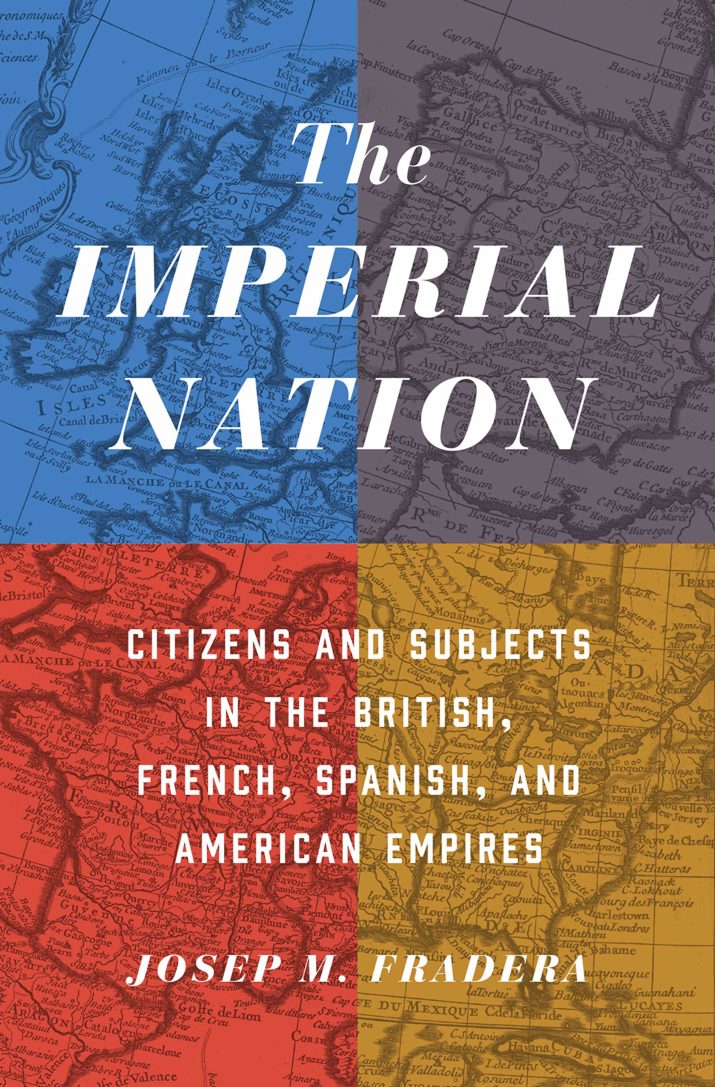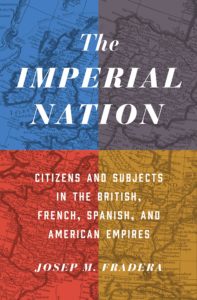
The Imperial Nation: Citizens and Subjects in the British French, Spanish, and American Empires by Josep M. Fradera (Trans. Ruth MacKay)

The Imperial Nation: Citizens and Subjects in the British French, Spanish, and American Empires is an important new book by Josep M. Fradera, Professor of Modern History at Pompeu Fabra University in Barcelona. Fradera, first and foremost a scholar of the Spanish Empire, previously has published widely on colonialism, slavery, and anti-slavery. In his first English-language book, translated by Ruth MacKay, Fradera synthesizes and updates his two-volume La nación imperial (Editorial Edhasa, 2015). His new book represents a turn outward in two ways: first, Fradera compares the Spanish Empire to its European rivals, placing all of them within the global context of successive waves of empire and revolution. Second, he engages with global historiography, situating himself within the tradition of John H. Elliot, Stanley J. Stein, and C.A. Bayly. The result is a convincing argument about the endurance of empire in the aftermath of revolution.
Fradera’s central claim is that the Atlantic revolutions of the late eighteenth and early nineteenth century were the product of, and prerequisite for, successive waves of empire. Throughout his argument, he emphasizes the people and events at the periphery of empires: monarchic empires populated by equal subjects, and ruled by singular imperial constitutions (7), increasingly were besieged by republican demands for civil rights. As taxation and military expenditures increasingly drew the state into colonial civil society, no longer was loyalty to a faraway monarch a sufficient basis for imperial unity. Instead, colonial subjects, drawing upon new understandings of political identity, representation, and personhood (10), proclaimed that the rights and responsibilities of citizenship belonged to them. Crucially, these revolutionary claims were taken up simultaneously in the metropolis and colonies—in the latter case by the enslaved, landless, and poor. Colonial revolutionaries combined the imperial notion of “the people” with republican ideals in ways that neither European monarchs nor metropolitan revolutionaries had anticipated. With their notions of subjecthood ill-fitting for the demands of the colonized, monarchic empires collapsed. Yet the seeds of the second age of empire were incipient in the fall of the first. Imperial nations reconstructed themselves as the sum of two clearly defined categories: metropolitan citizens and colonial subjects (191). Whereas citizens were endowed with civic responsibilities, subjects were governed by “special laws” (3).
The scope of Fradera’s book is impressive: he recounts the succession of imperial expansion, popular revolution, and imperial recovery in the British, French, Spanish, and American Empires over the course of two centuries. Given the nature of his argument—on the causes and significance of imperial recovery in the early nineteenth century—comparisons across time and space are essential. Yet these four cases (interspersed with references to the Dutch, Portuguese, and other European empires) are particularly illustrative of Fradera’s argument: Spain’s early conquests and rapid decline gave way to continuity; Britain’s loss of the Thirteen Colonies provided the impetus for imperial reform, stabilization, and dominance; revolution and instability in France preceded a military recovery and a model imperial legal code; and the United States combined its vision of democracy with expansionist settler colonialism and an economy built on slavery.
The four case studies are interwoven into a global story: empires were driven by war and rivalry with one another, drew lessons from one another’s imperial exploits, and gradually developed a common approach to colonial governance through “specialness.” In the Spanish case, for example, this led to the reproduction of British assemblies and councils in its colonies, as well as the “outright plagiarism” of Napoleonic law (135). The demise of the Spanish Empire came in 1898, when its clash with the United States in Cuba demonstrated that “in both cases, nation and empire were one” (153). Yet equally significant to imperial history were colonial subjects, who shaped events in the metropolis. Fradera argues that settler colonists, in particular, perceived themselves as birthright subjects of monarchical empires, whose status was not diminished by distance. Consequently, British settler colonists sent representatives to Parliament, and sought to influence military and trade policy. The British Empire’s attempts to distinguish between settler colonists in its North American colonies and subjects in the metropolis prompted the Thirteen Colonies to revolt, with reverberations for all European empires. Elsewhere, enslaved people in Sainte Domingue embraced the values of the French Revolution, rising up against white planters to proclaim that the Revolution guaranteed their rights, too.
Paradoxically, in interweaving the stories of metropolis and colonies, and in emphasizing their mutual constitution, Fradera cedes space for the oppressed. His treatment of the Haitian Revolution is surprisingly brief: he describes the war as the “self-emancipation of the slaves” in the context of a “complete vacuum of power” in Sainte Domingue (61). Elsewhere, he omits the Haitian Revolution from a list of Atlantic revolutions (53). While Fradera devotes more attention to this war later in the book, he retains the perspective that the Haitian Revolution was an unintended derivative of the French Revolution. The voices of its leaders are absent, as is any reference to the inspiration they derived from West African rather than European ideals of humanity and liberty (see, for example, Cauna 1996; Dubois 2004; Eddins 2014; Rucker 2001; Thornton 1993). This is a significant omission, given that the Haitian Revolution, far more so than the American Revolution, proclaimed that European empires were populated by equal political subjects with civil and social rights. These demands, in metropolis and colonies alike, made the monarchic model of eighteenth-century empires untenable.
These issues notwithstanding, the importance of “race” (and, more to the point, racialization) for European imperial projects is a central theme of the book. Fradera emphasizes that prior to the first age of empire, there was no concept of race as phenotype, nor any exclusion of entire populations from humanity on that basis. Certainly, during the period of early European settlement in the Americas, exclusion was an increasingly salient source of tension between settler colonists eager to defend their subject status and more distant metropolitan lawmakers whose primary concerns were economic. Yet in the colonies, exclusion was not, initially, on the basis of “race.” The 1812 Constitution of Cadiz, for example, carefully delineated the categories of people who would be included in (Iberians, settler colonists, Indians) and excluded from (the enslaved and, to some degree, the castas pardas) citizenship through a “cost-benefit analysis” calculated to secure the power of the political class ( 66). “Race” emerged forcefully as a political category in the eighteenth century, when the explosion of the Atlantic slave trade, combined with the expulsion or genocide of indigenous peoples and demands for rights by European subjects, exacerbated fractures within the category of colonial subjects. After the demise of empire and the age of revolution, the second wave of imperial expansion attained stability by dividing citizens and subjects along the color line. In the United States, for example, rhetoric and policy at the end of the nineteenth century drew an unassailable barrier between citizens (“We, the People”) and racialized Others. Thus, when the Philippines passed from Spanish to American control, the U.S. imposed regressive measures that deprived Filipinos of citizenship, suffrage, and self-government (184). Once the formerly enslaved, forced laborers, and indigenous groups had been excluded from personhood, it became possible to deny the universality of political and social rights. The result of racialization was exclusion and degradation—and, conversely, citizenship. As Fradera writes, “advances in the rights of some were accompanied by their diminishment or obliteration in the case of others” (221).
Herein lies the book’s most significant contribution: the political category of “specialness.” Fradera argues that during the second wave of empire, Europeans transformed their understanding of imperial space from a unified, geographically dispersed empire of monarchic subjects into a clearly defined metropolitan center of citizens and a peripheral expanse of colonial subjects (236). The former were constituents of the nation who held civic rights and responsibilities; the latter were “prepolitical subjects” or “alienated slaves” (236) ill-suited for participation in civic institutions. Citizenship was blurred in the borderlands between nation and empire—in the four communes of French West Africa, or along the Algerian coast. There, (assimilated, male) colonial subjects could, in theory, prove their worthiness for citizenship (223). Yet the ambivalence of these categories prompted the metropolis to brighten the border between citizens and subjects, by racializing the colonized Other and by imposing draconian laws that governed subjects’ daily lives. Conversely, with the geographic and racial parameters of the nation clearly defined, metropolitan citizens enjoyed a broader, deeper set of political and social rights. Suffrage, the foremost of citizens’ rights, was extended to an ever-greater proportion of the metropolitan population. But, as Fradera demonstrates, constructing the nation was only made possible by forcefully excluding racialized Others—both from citizenship and from personhood. In the present political moment, amidst a global surge of populist nationalism, this point seems especially prescient.
Reviewed by Meghan Tinsley, The University of Manchester
The Imperial Nation: Citizens and Subjects in the British French, Spanish, and American Empires
By Josep M. Fradera
Trans. Ruth MacKay
Princeton University Press
Hardcover, 416 pages, October 2018
References
Cauna, Jacques. “The Singularity of the Saint-Domingue Revolution: Marronage, Voodoo, and the Color Question.” Plantation Society in the Americas III, no. 3 (1996): 321-345.
Dubois, Laurent. Avengers of the New World: The Story of the Haitian Revolution. Cambridge, MA: Harvard University Press, 2004.
Eddins, Crystal N. “Seeds of Discontent: Antecedents to the Haitian Revolution 1750-1791.” Master’s thesis, Michigan State University, 2014.
Rucker, Walter. “Conjure, Magic, and Power: The Influence of Afro-Atlantic Religious Practices on Slave Resistance and Rebellion.” Journal of Black Studies 21, no. 1 (2001): 84-103.
Thornton, John K. “‘I Am the Subject of the King of Congo’: African Political Ideology and the Haitian Revolution.” Journal of World History no. 4 (1993): 181-214.
To read more book reviews click here.
Published on April 2, 2019.




